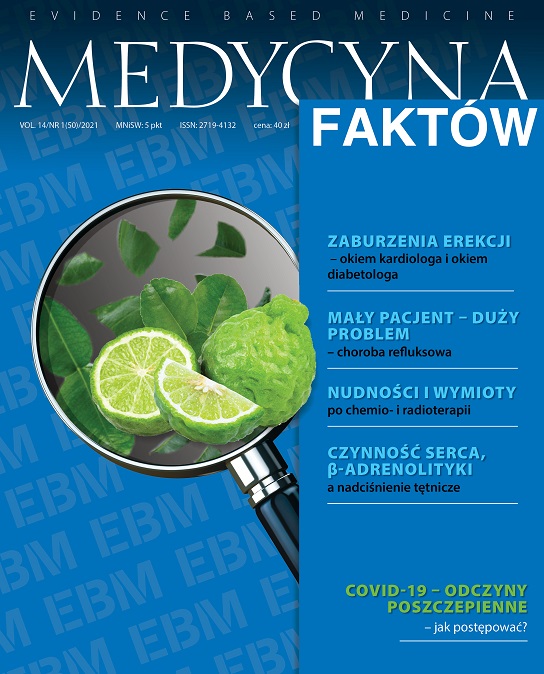Bezpieczeństwo i skuteczność mirabegronu i solifenacyny w leczeniu nadaktywnego pęcherza moczowego u pacjentów w wieku podeszłym Artykuł przeglądowy
##plugins.themes.bootstrap3.article.main##
Abstrakt
Objawy ze strony dolnych dróg moczowych, w tym parcia naglące, nietrzymanie moczu spowodowane parciem, częstomocz i nykturia, są powszechne u osób starszych i wiążą się ze znacznym pogorszeniem jakości życia. Gdy postępowanie zachowawcze, takie jak modyfikacja przyjmowania płynów czy trening pęcherza, nie łagodzi objawów, zaleca się wdrożenie postępowania farmakologicznego. Leki antymuskarynowe jako leki pierwszego rzutu w leczeniu pęcherza nadaktywnego blokują aktywność muskarynowych receptorów M2/M3 w pęcherzu i zapewniają znaczące korzyści kliniczne w terapii objawów pęcherza nadaktywnego u osób starszych, lecz ich skutki uboczne są częste, co niejednokrotnie prowadzi do dyskontynuacji leczenia. Mirabegron, agonista receptora β3-adrenergicznego, wykazuje podobną skuteczność jak leki antymuskarynowe bez ryzyka działania antycholinergicznego.
##plugins.themes.bootstrap3.article.details##
Copyright © by Medical Education. All rights reserved.
Bibliografia
2. Abrams P, Cardozo L, Fall M et al. The standardisation of terminology of lower urinary tract function: report from the Standardisation Sub-committee of the International Continence Society. Neurourol Urodyn. 2002; 21(2): 167-8.
3. Wagg A, Gibson W, Ostaszkiewicz J et al. Urinary incontinence in frail elderly persons: report from the 5th International Consultation on Incontinence. Neurourol Urodyn. 2015; 34(5): 398-406. https://doi.org/10.1002/nau.22602.
4. Irwin DE, Milsom I, Hunskaar S et al. Population-based survey of urinary incontinence, overactive bladder, and other lower urinary tract symptoms in five countries: results of the EPIC study. Eur Urol. 2006; 50(6): 1306-14. https://doi.org/10.1016/j.eururo. 2006.09.019. discussion 1314-5.
5. Abrams P, Artibani W, Cardozo L et al. Reviewing the ICS 2002 terminology report: the ongoing debate. Neurourol Urodyn. 2009; 28(4): 287. https://doi.org/10.1002/nau.20737.
6. Abrams P, Cardozo L, Fall M et al. The standardisation of terminology of lower urinary tract function: report from the Standardisation Sub-committee of the International Continence Society. Neurourol Urodyn. 2002; 21(2): 167-78. https://doi.org/10.1002/nau.10052.
7. Sakakibara R, Panicker J, Fowler CJ et al. Is overactive bladder a brain disease? The pathophysiological role of cerebral white matter in the elderly. Int J Urol. 2014; 21(1): 33-8. https://doi.org/10.1111/iju.12288.
8. Brading AF. A myogenic basis for the overactive bladder. Urology. 1997; 50(6A Suppl): 57-67; discussion 68-73. https://doi.org/10.1016/S0090-4295(97)00591-8.
9. de Groat WC. The urothelium in overactive bladder: passive bystander or active participant? Urology. 2004; 64(6 suppl 1): 7-11. https://doi.org/10.1016/ j.urology.2004.08.063.
10. Gary B, Perera S, Murrin A et al. White matter hyper-intensity burden and depression are associated with severity and impact of urgency urinary incontinence in functional, community-dwelling older women. Neurourol Urodyn. 2013; 32(6): 798-9.
11. DuBeau CE, Kuchel GA, Johnson IIT et al. Incontinence in the frail elderly: report from the 4th International consultation on incontinence. Neurourol Urodyn. 2010; 29: 165-78.
12. DuBeau CE. The aging lower urinary tract. J Urol. 2006; 175: 811-5.
13. NICE UK. Urinary Incontinence: The Management of Urinary Incontinence in Women (CG40); 2006.
14. Corcos J, Przydacz M, Campeau L et al. CUA guideline on adult overactive bladder. Can Urol Assoc J. 2017; 11(5): E142-E73. https://doi.org/10.5489/cuaj.4586.
15. Wagg A. Treating overactive bladder in the elderly. Can Urol Assoc J. 2011; 5(5 suppl 2): S149-51. https://doi.org/10.5489/cuaj.11188.
16. Chapple CR, Dvorak V, Radziszewski P et al. A phase II dose-ranging study of mirabegron in patients with overactive bladder. Int Urogynecol J. 2013; 24(9): 1447-58.
17. Shaw C, Tansey R, Jackson C et al. Barriers to help seeking in people with urinary symptoms. Fam Pract. 2001; 18(1): 48-52. https://doi.org/10.1093/fampra/18.1.48.
18. Riva D, Casolati E. Oxybutynin chloride in the treatment of female idiopathic bladder instability. Results from double blind treatment. Clin Exp Obstet Gynecol. 1984; 11(1-2): 37-42.
19. Chapple C, Van Kerrebroeck P, Tubaro A et al. Clinical efficacy, safety, and tolerability of once-daily fesoterodine in subjects with overactive bladder. Eur Urol. 2007; 52(4): 1204-12. https://doi.org/10.1016/j.eururo.2007.07.009.
20. Sexton CC, Notte SM, Maroulis C et al. Persistence and adherence in the treatment of overactive bladder syndrome with anticholinergic therapy: a systematic review of the literature. Int J Clin Pract. 2011; 65(5): 567-85. https://doi.org/10.1111/j.1742-1241.2010.02626.x.
21. Wagg A, Dale M, Tretter R et al. Randomised, multicentre, placebo-controlled, double-blind crossover study inves- tigating the effect of solifenacin and oxybutynin in elderly people with mild cognitive impairment: the SENIOR study. Eur Urol. 2013; 64(1): 74-81. https://doi.org/10.1016/j.eururo.2013.01.002.
22. Michel MC. β-Adrenergic receptor subtypes in the urinary tract. Handb Exp Pharmacol. 2011; 202: 307-18.
23. Keam SJ. Vibegron: first global approval. Drugs. 2018; 78(17): 1835-9. https://doi.org/10.1007/s40265-018-1006-3.
24. Khullar V, Amarenco G, Angulo JC et al. Efficacy and tolerability of mirabegron, a beta(3)-adrenoceptor agonist, in patients with overactive bladder: results from a randomised European-Australian phase 3 trial. Eur Urol. 2013; 63(2): 283-95. https://doi.org/10.1016/j.eururo.2012.10.016.
25. Wagg A, Cardozo L, Nitti VW et al. The efficacy and tolerability of the beta3-adrenoceptor agonist mirabegron for the treatment of symptoms of overactive bladder in older patients. Age Ageing. 2014; 43(5): 666-75. https://doi.org/10.1093/ageing/afu017.
26. Wagg A, Staskin D, Engel E et al. Efficacy, safety, and tolerability of mirabegron in patients aged ≥65 years with overactive bladder wet: a Phase IV, double-blind, randomised, placebo-controlled study (PILLAR). Eur Urol. 2020; 77(2): 211-20.
27. Abrams P, Kelleher C, Staskin D et al. Combination treatment with mirabegron and solifenacin in patients with overactive bladder: efficacy and safety results from a randomised, double-blind, dose-ranging, phase 2 study (Symphony). Eur Urol. 2015; 67(3): 577-88. https://doi.org/10.1016/j.eururo.2014.02.012.
28. Oelke M, Becher K, Castro-Diaz D et al. Appropriateness of oral drugs for long-term treatment of lower urinary tract symptoms in older persons: results of a systematic literature review and international consensus validation process (LUTS-FORTA 2014). Age Ageing. 2015; 44(5): 745-55. https://doi.org/10.1093/ageing/afv077.
29. Chapple CR, Mironska E, Wagg A et al. Multicriteria decision analysis applied to the clinical use of pharmacotherapy for overactive bladder symptom complex. Eur Urol Focus. 2019. https://doi.org/10.1016/j. euf.2019.09.020.
